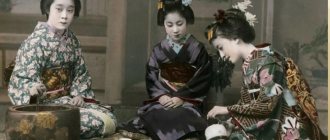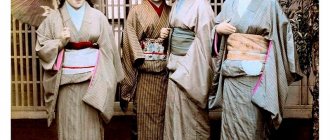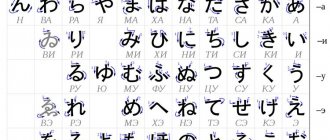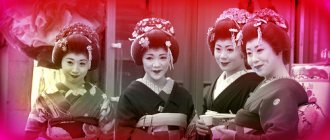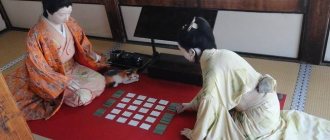Japanese shoes can boast of quite a rich history. Despite the fact that now most residents of the Land of the Rising Sun wear shoes, sneakers and other European footwear, traditional shoes have not disappeared anywhere.
It all started with the fact that some types of shoes were borrowed from China. A couple of thousand years ago, China was the most developed Asian state. There is nothing surprising in the Japanese desire to use local technologies to their advantage. At the same time, shoes began to be strictly divided into: open and closed.
Shoe traditions of Japan
Below is a list of Japanese shoe traditions:
— When entering a house, shoes must be taken off . The Japanese, like the Russians, are very surprised when they see Europeans and Americans who can keep their shoes on almost the whole day and move around their living space in them. For clean residents of the Land of the Rising Sun, this is unacceptable, as a result of which shoes are usually left at the door.
— Cleanliness and tidiness are important . You will have to try hard to find a person in Japan who is willing to wear dirty or downright shabby shoes. Typically, locals regularly clean out their wardrobe items and replace them with something new when the situation demands.
— There should be a lot of shoes . The Japanese have a lot of shoes. For example, when visiting, a person may be offered soft slippers (surippa), but when going to the restroom, he will have to change into special slippers. It is also not customary to come to special occasions in casual shoes, and for visiting sacred temples there is even a separate pair that is not worn on other occasions. As a result, the average Japanese person may have dozens of pairs of shoes in their wardrobe.
— National shoes are relevant only on holidays . Considering the fact that traditional Japanese shoes (discussed below) are not very comfortable, they are usually worn only during holidays. In combination with a kimono and other similar clothing, it looks extremely attractive.
LiveInternetLiveInternet
下駄geta is the name of Japanese footwear, a type of open clog worn with a kimono, originally consisting of a straight wooden sole.
Looking at them, one can say that they definitely contribute to flat feet, however, people walked on them, ran, and special craftsmen danced and fought.
Heels are called “teeth” - “ha”, there can be 1,2 or 3 of them.
Kinds:
1.吉原下駄 – Yoshiwara (actually, more correctly Yoshihara)-geta – shoes of the residents of Yoshiwara, i.e. Oiran and melt. Marching, medium formal courtesan shoes made of 2 heels of equal height (10 cm), the toe has a wide heel (tooth).
2. ぽっくり下駄 Pokkuri-geta, 木履 Pokkuri, Koppori-geta, おこぼ等々 Okobo toudou (slightly lower than usual) - geisha shoes, maiko, geiko, kaburo, kamuro. Platform 10-20cm in height with a right angle-slope to the toe.
3. 柳下駄 Yanagi-geta - willow geta, worn by geisha on non-ceremonial occasions at the end of the 17th century. Slightly rounded rectangular shape, with 2 low heels.
4. 桐下駄 Kiri-geta - geta for men, without heels, or with small ones, instead of straps, sometimes a semi-closed shape, dark colors.
5. 助六下駄Sukeroku-geta, Funagata 舟形 - geta of Kabuki actors with a round sole (boat). Although other types are also used there.
6. 右近下駄 Yukon-geta - the closest to the usual image of shoes.
7. 日和下駄 Hiyori-geta, 利久下駄 Toshihisa-geta – ceremonial shoes, predominantly for men, with two thin teeth. Sometimes they are covered with leather. Some species have removable rain socks.
8. 鉄下駄 Tetsu-geta - iron geta, even more deadly than usual X) Used for training shugendo warriors (ninja, yamabushi). 鬼の下駄 “Oni no geta” is sometimes called “demon geta.” They are fastened together with a chain so that the legs do not move apart. It’s even difficult to imagine how you can lift your leg, the fastening is only between the thumb and index finger, but this explains how ninjas learned to fly, because it’s impossible to walk in such shoes)
(they mostly ran in foot wraps)
9. 高下駄 Taka-geta - the next sophisticated torture - very high geta (over 30cm) on a solid platform (seri-geta せり下駄), sometimes there are ropes at the bottom along the edge of the sole - against sliding. Dress shoes oiran and melt.
A) 二本歯足Nibonha-ashi on 2 teeth – they are even higher.
B) 三本歯足Sambonha-ashi, 三本足Sambon-ashi, 花魁の下駄 Oiran no geta - their variety, the same high, but the platform consists of 3 teeth.
10.一本歯 Ipponha, 厚歯 Atsushiha, 天狗下駄 Tengu-geta - for training, again, shugendo, walking of priests and warrior-priests (yamabushi). According to legend, they were given to ascetics by the tengu themselves, their teachers, for the practice of dexterity. They are tall, then sometimes taka-geta is added to the name.
11. 田下駄 Tageta – geta of the Yayoi era, i.e. the most ancient (which refutes the version of the arrival of geta from China) were used by peasants.
12. 下駄スケートGeta – sukeeto – geta on an iron wire or on a blade for skating on ice.
13. 八ツ割 Yatsuwari – bamboo/cork soft geta with cut plastic.
14.草履 Zouri - sandals, without heels or with a comfortable instep, a small platform, the most comfortable modern type of shoe for a kimono.
Examples of Japanese shoes
I would like to highlight the three most popular models of Japanese shoes:
— Geta . Such shoes are a board, selected to fit the size of the foot, at the base of which two bars are attached. To secure it to the leg, a ribbon/string is used, threaded between the thumb and index finger. It is thanks to the constant wearing of such shoes that Japanese women have had a specific “flying gait” for many centuries. The thing is that geta does not allow you to take a wide step without additional effort, as a result of which the women moved very smoothly, and from the outside it seemed as if they were floating above the surface of the earth.
- Pokkuri . Shoes of this type attract attention due to the height of the platform (from 7 to 12 centimeters) and the design, extravagant by European standards. In general, pokkuri have never been a particularly popular shoe. They were worn exclusively by maiko - girls who would become geishas in the future. Similar shoes are still produced in Japan, but are very expensive and are used exclusively during various ceremonies. Therefore, it is almost impossible to meet a girl wearing pokkuri on the streets of Tokyo or any other city.
— Zori . This model does not imply the presence of heel bars. However, the sole here is not straight - there is a noticeable thickening in the heel area. It was decided to abandon the use of wood in the shoe production process. It was replaced by leather, and later by rubber and other synthetic materials. But the technique of attaching to the leg remained unchanged. Nowadays the Japanese do not wear such shoes every day, but they do when they undergo a ritual dedicated to coming of age.
Note: buy inexpensive and comfortable shoes on the website www.cheap-obuv.rf. Here you will find a wide range of men's, women's and children's shoes at an affordable price.
<Japanese culture in landscape design
Japanese incense art>
Geta and zori - national Japanese shoes
National Japanese footwear has undergone a number of great changes throughout its history of formation and development.
The enormous influence of Western trends on the development of the economic and political situation in the country radically influenced the appearance of the Japanese, who gradually began to move away from their traditional clothing, replacing it with a more Europeanized style. Today, European clothing styles have flooded the closets of every modern Japanese. You can now recognize a Japanese person by their gait only at various carnivals and festive processions dedicated to national holidays.
What is the distinctive feature of the Japanese gait? It's all about the shoes. National Japanese shoes, quite unusual and specific for Europeans, have ceased to be used for everyday wear in modern Japan, unable to withstand competition with convenient and comfortable shoes of European models.
Shoes in Japan
Only the Japanese trend in the world of shoes remains unchanged - no one can boast of such regular and frequent changes of shoes as the inhabitants of the Japanese islands. For each occasion, the Japanese have their own specific shoes.
To walk down the street, Japanese residents wear zori or geta , which have been a necessary wardrobe attribute for several centuries. When entering a house, the Japanese change their shoes into soft shoes called surippa . When going to the restroom, the Japanese will change his shoes again and put on special slippers. Separate shoes are required for visiting shrines and temples.
The history of the formation of Japanese shoes is as unusual and interesting as Japanese culture itself. Initially, zori were universal shoes that fit with any clothes and were worn for all occasions.
Geta is a specific shoe called a bench. Geta is a wooden platform that is placed on two pieces of wood. This structure is attached to the leg using special ribbons or ropes that are threaded between the thumb and forefinger.
It was impossible to take a wide step in such shoes, so all Japanese women walked in small steps, creating the effect of floating in the air. It was this kind of gait that was the only acceptable one for a Japanese woman.
Shape and other features of geta shoes
Several centuries ago, wood was used to make geta.
Despite the specific design, from which it seemed impossible to make anything larger, geta had several style varieties. Geta can have a round toe, which was worn preferably by older people and temple servants, and a square-toed geta, which was worn by the middle-aged.
There is another type of geta - nomeri, which is distinguished by tilting the toe forward. Such shoes are especially appreciated by pop stars and representatives of creative professions.
Geta had not only a different toe shape, but also the material that was used to finish the shoes. The material differed from the social class of the person, as well as from the time of year.
Geta for men had a less aesthetic appearance than women's models, but was distinguished by the high quality of the wood, which belonged to noble wood species, and the surface of the geta was decorated with carvings of intricate patterns. Women's models, used for special occasions, were decorated with brocade fabric, and in appearance they were very similar to modern slates.
In winter, or for residents of mountainous areas, such geta were made much higher to protect their feet from the cold. Today, the modern Japanese woman prefers to wear comfortable sandals made from soft materials to work.
Zori – a unique model of sandals
A characteristic feature of zori is the absence of a heel, but the presence of a thickened sole in the heel area. Zori is one of the most comfortable types of shoes, worn for daily wear. To make zori, straw, leather, and various synthetic materials, such as vinyl, are used.
Today on the streets of Japan you no longer see girls and women walking with a shallow, shuffling gait. The Japanese love and respect their traditions very much, so traditional Japanese shoes are required to be worn during various religious ceremonies, in particular, but a ritual of coming of age, which occurs in Japan at the age of 20. Such shoes are worn for wedding ceremonies by stage and film figures.
Video: Learning Japanese numbers
Japanese "slippers" geta
Geta is one of the most ancient types of Japanese shoes. It’s difficult to say exactly when “stools” came into use, but remains of wooden shoes and stone models are found in some burials of the Kofun period, i.e. III-VI centuries.
Here, for example, is a stone carved model of a geta (about 12 cm long) found in the Kagamiyama burial site in what is now Kyoto Prefecture.
It is said that geta was originally used for working in the fields. But then we adapted and just walked around in it, and also showed off and showed off.
Over the past centuries and even millennia, the board with crossbars has been modified many times to suit the different needs and requirements of its bearers.
Since geta were invented for working in the field, here are several variations of the so-called “tageta” (field geta).
Slurping through a rice field and not drowning in liquid mud is the main goal of such structures.
Variation on the same theme.
Or like this:
Since these “slippers” were not distinguished by grace and lightness (especially in combination with the dirt stuck to them), ropes were often attached to them for control.
Like that.
A modification of these work slippers can be considered shoes for working in deep, but not swampy places. At sea, for example.
The so-called “nori-geta” (you know nori, right? They wrap sushi in it, it’s like seaweed). Pebbles on the bottom so they don't float up.
The same structures were used in the construction of bridges, especially since the height could be made to almost any height (within reason, of course).
Shoes with a built-in stepladder. They claim that the height of the “stepladder” varied from 30 cm to 1 meter. How they were climbed is unknown. Probably a ladder was included.
Variation on the theme of nori-geta. If you have a couple of buckets leaking, don’t throw them away, they’ll come in handy.
Well, ordinary walking and general-purpose geta look like this (who doesn’t know?):
The board is either rectangular or oval in shape with two crossbars - “heels” and straps into which the feet are inserted.
Interestingly, the ancient geta were done on the right and left legs separately:
Remains of wooden geta from a burial from the time of Nara (8th century).
But by the Heian period they stopped dabbling in this and cut out identical boards for both legs with symmetrical holes for straps.
New geta do not differ between right and left sneakers, but during wearing, the straps are slightly stretched to fit the shape of the legs, and the “heels” are ground down depending on the characteristics of the gait, and the geta begin to differ.
The upper rectangular two-heel model is the most versatile. This is worn by both girls and boys of all ages. Both for work and for holidays.
The height of the “heels” can vary very widely. From complete absence (as in tageta) to half a meter and above. There can also be two, one, or three “heels”.
“One-toothed” geta, also called “tengu-geta” (tengu is a very long-nosed hero of local mythology).
Variations in the height of single-toothed geta. This is, so to speak, average for the average consumer.
And here are the models for the spiritually developed:
Footwear of Buddhist monks. 60 cm, they say, for special uplifting spirit.
By the way, about monks. Shoe sample kept at Kyomizu-dera Temple in Kyoto:
It is said to have belonged to the monk Benkei, a hero of the very late Heian era. Iron geta, weighing 12 kg each slipper. Those who wish can now try it on and walk around.
Also for the spiritually developed, but in a different area:
Three-heeled variation of geta for high-ranking prostitutes such as tayu and oiran. Up to 30 cm tall.
A more modest variation of women's geta, for young noble girls and girls:
This is, of course, a modern model, but not much different from earlier ones. This is usually worn by girls to celebrate 3-5-7.
Richer model:
Models of about the same height, but without the design and with a bell built into the nose, are worn by maiko (apprentice geishas) of Kyoto. This is called “pokkuri” (imitation of the sound made when walking) or “okobo”.
Here is another model of geta workers, albeit a rather specific one:
In a box and with a braid of rice straw to prevent knocking. These are “butai-geta”, in which the leading performers of the bunraku puppet theater walk across the stage. Those who carry a doll and play its role. All kinds of auxiliary artists, those in charge of the movements of legs, hems, tails and other minor details, wear warajs woven from rice straw on stage in order to be obviously lower than the main artist.
This is roughly what it looks like from the inside.
Please note: traditional Japanese geta have a strictly horizontal, flat surface. But at the beginning of the 20th century, European trends penetrated into this area. And the geta began to acquire smooth curves in the shape of the foot.
This is already European influence. Although the slippers are still “on one leg”.
An intricate variation from a century ago:
A hybrid, so to speak. And that was it.
At the beginning of the 20th century, geta took part in the Winter Olympic Games. As racing skates, yes.
To avoid getting lost in the process, they were also tied to their feet with ropes.
Also skates. Apparently especially balanced.
A more practical and convenient geta model for wet and cold weather:
With nose cover and fur trim.
This, too, is said to have appeared under European influence:
The base is like that of geta. But there are no straps anymore, just one bridge across the entire foot. These are very popular here in onsen and as toilet slippers.
Well, nowadays there are all kinds of geta. The traditional ones are still in use, with the exception of tageta and nori-geta. Now there are more convenient ways to work in the field and at sea. And few people use geta skates either.
Geta models
Looking at a particular geta model, you can easily determine the status of its owner.
- Kaku geta - a model worn by middle-aged Japanese, has a rectangular platform;
- Geta with rounded corners are preferred by older Japanese or priests;
- Nomeri geta - shoes of Japanese actors (this model has a slightly noticeable forward slope).
The decoration of men's and women's geta differs. For Japanese men, it is important what type of wood these shoes are made from, the grace of the carvings applied to the geta and the quality of the varnish. The elegant geta of Japanese beauties were usually covered with brocade and gilding. They often look like the flip-flops we are all familiar with, although their winter version has rather high supports. By looking at female geta, you can quite easily determine what age category their owner belongs to.
The Japanese still sacredly honor traditions. This, of course, also applies to the culture of wearing clothes and shoes: geta are worn on coming of age celebrations (for the Japanese this means reaching twenty years old), during a marriage ceremony, they are worn by geishas and all those representatives of Japanese society who dress in kimonos.
History of wooden shoes
Ancient Rome
The history of wooden shoes began long before the emergence of modern European states. In ancient Rome, prisoners were forcibly put on wooden legs, tying them to their legs with strips of fabric, which made escape extremely difficult.
Japan
Japanese geta have a wooden sole in the shape of a bench, the first information about which dates back to the 10th century AD. Geta were the main footwear of women and men from different segments of the population until the mid-twentieth century.
Ardennes
Classic clogs first appeared in the Ardennes mountains, located in France, Belgium and Luxembourg. They were most popular among peasants and artisans. Shoes could be made entirely of wood, like French clogs, or have a leather or suede upper, like Dutch clogs. Following the Ardennes, wooden shoes spread throughout Europe because they were very durable and protected feet from water and dirt.
Netherlands
In the 70s of the 16th century, a guild of shoemakers producing wooden clogs was formed in the Netherlands. The local population called them “klopfs”. Since that time, wooden shoes have become popular and affordable. Clogs were made from willow, birch, beech and other woods that did not split or crack when worn. Wooden ones were comfortable, durable, waterproof, and also cheap, so they were worn both on weekdays and on holidays. Basically, similar shoes were used by residents of lowland countries: mountainous areas required more flexible shoes that would allow them to climb and move on steep and uneven surfaces.
France
From the 16th to the 18th centuries, clogs were worn by French fashionistas from the upper classes. Another mention of clogs dates back to 1793, when wooden, mule-heeled shoes were made for the French army. The upper strata of society wore clogs only in chilly and slushy weather, because due to their bulkiness, this type of footwear could not be used for going out. French clogs were attached to the foot using metal hoops.
Great Britain
Clogs came to England in the 19th century, much later than to other European countries. They were distributed among workers of rural mills in the northern regions of the country.
USA and Europe
In the 20th century, clogs were revived by Dutch designer Jan Jansen. He developed the modern model in 1969. Wooden shoes were worn by the legendary rock singer Janis Joplin, and in the 70s, in the wake of love for ethnicity and the desire for naturalness, clogs became a mandatory attribute of style. Then, in addition to wooden models, light clogs with cork soles appeared, as well as on polyurethane platforms, which in the USSR were called “semolina porridge”. In the USA, “corks” were popular - clogs produced by the Kork-Ease company. The designer (Betsey Johnson) had about 30 crust models.
Sweden
In 2006, clogs under the Swedish Hasbeens brand appeared in Stockholm. According to legend, this happened after Amy Blixt and Cilla Wingård Neuman opened a second hand store, which included several dozen pairs of clogs from the 70s fashionista Anita. The design and convenience of the model were to the taste of customers, and Amy and Zilla decided to produce clogs themselves. In 2008, Swedish Hasbeens was named the brand of the year at the Trend Award Gala in Stockholm. Currently the company has operations in 16 countries. In 2011, the Hasbeens for clog was created.
Fashion world
After the boom of the 70s, clogs were long forgotten by the fashion world. A model made of pony leather appeared in the late 90s in the Marni collection, but the triumphant march along the world catwalks of clogs began only in 2010 - after appearing at the shows of, and. The new clogs were decorated with rivets, fur tassels, flowers and stones. Celebrities began to wear them: Ashlee Simpson, Rachel Bilson, Michelle Williams, Mischa Barton, etc. Democratic brands began to produce budget versions of shoes with wooden soles. In the autumn-winter collections of 2010-2011, clogs were presented in the collections of many: Chanel, etc. Clogs even appeared in the collection. By 2012, the popularity of clogs had noticeably decreased, but some brands still offer them, although more often in versions that are far from the original.
Japanese women's kimono shoes: geta, zori, setta Traditional and modern handmade Japanese women's shoes for indoors and outdoors. Shoe sizes are given in centimeters. When choosing the appropriate shoe size, simply measure and indicate the length of your foot in centimeters.| G-066 Japanese wooden geta shoes Material: wood, varnish, painting, kimono fabric. Size: L (foot length 23.5-24.5 cm) Heel height 5 cm Stylish Japanese traditional shoes made of solid wood Handmade. Price: $82 |
| G-039 Japanese wooden geta shoes Material: solid light wood (paulownia), traditional kimono fabric Size: LL (foot length 24.5-25.5cm) Heel height: 4.5cm Handmade traditional Japanese outdoor shoes SOLD OUT |
| G-024 Japanese traditional zori shoes O-bon Material: Japanese grass igusa , colored kimono fabric Sizes: S (foot length 22-23 cm) M (foot length 23-23.5 cm) L (foot length 23.5 - 24.5 cm) LL ((24.5 - 25.5 cm ) Lightweight and comfortable shoes for the house. Japanese grass igusa has bactericidal properties. Handmade. Price: $55 / $62 |
| G-054-R Japanese cherimen kimono fabric setta shoes Material: kimono fabric cheryman , vinyl sole Size: L (24.5 cm) Stylish shoes for indoors and outdoors. Handmade. Price: $78 |
| G-040-16w Japanese wooden geta shoes Material: wood, carving, kimono fabric. Size: LL (foot length 26.0-27.0 cm) Heel height 3 cm Comfortable and lightweight shoes for the street Handmade. Price: $82 |
| G-067 Japanese wooden geta shoes Material: natural wood, colored kimono fabric. Size: LL (foot length 24-25 cm) Heel height 4 cm Traditional Japanese outdoor shoes. Handmade. Price: $80 |
| G-060 Japanese stylish zori shoes Material: Japanese igusa grass, colored kimono fabric. Sizes: L (foot length 23.5-24.0 cm) - blue-violet color LL (24.0-25.0 cm) - various colors Lightweight and comfortable handmade shoes for the home. Japanese grass igusa has bactericidal properties. Price: $42 |
| G-047 Japanese wooden geta shoes Material: wood, colored kimono fabric Size: M (foot length 23.0-24.0 cm) Heel height 4 cm Stylish shoes and comfortable handmade outdoor shoes Handmade. SALES |
| G-021 Japanese traditional tabi socks Material: cotton, metal clasp Dimensions: 24 cm and 24.5 cm Japanese traditional socks with hard soles for kimono. Color: white SOLD OUT |
| G-056 Japanese kimono fabric patterned shoes Material: polyurethane Size: 23.5-24 cm Exclusive original design indoor and outdoor shoes Price: $82 |
| G-044-P Wooden shoes Geta Material: wood, fabric of traditional Japanese kimono Size: L (foot length 25-26.5 cm) Traditional Japanese shoes made of solid light wood (paulownia) with a wicker cover. Handmade. Price: $85 |
| G-062 Japanese shoes Tatami-3 Material: Japanese igusa grass, colored kimono fabric. Size: L (23.5-24.0 cm) Light and beautiful shoes for the house. Japanese grass igusa has bactericidal properties. Handmade. Price: $32 |
| G-054-W Japanese cherimen kimono fabric setta shoes Material: kimono fabric cheryman , vinyl sole Size: L (24.5 cm) Stylish shoes for indoors and outdoors. Handmade. Price: $78 |
| G-068 Japanese wooden geta shoes Material: natural wood, colored kimono fabric. Size: LL (foot length 24-25 cm) Heel height 4 cm Traditional Japanese outdoor shoes. Handmade. Price: $80 |
| G-054 Japanese setta shoes Material: vinyl, colored kimono fabric, polyurethane sole. Size: L (23.5-24.5 cm) Stylish and original shoes for home, beach and street Price: $52 |
Women's shoes for kimono
Section topics: Japanese traditional shoes, Japanese women's shoes, clothing and shoes for the home, buy Japanese kimono online, kimono, traditional Japanese clothing, Japanese style, Japanese kimono in a modern interior, Japanese shoes made of wood, geta, tabi, zori.
Zori – soft sandals
Nowadays, the costume of charming Japanese women is usually complemented by zori - comfortable sandals with a fabric insole. Zori do not have heels, but are equipped with a seal in the heel area. Zori are multifunctional: they are worn on holidays with a traditional kimono, but their owners feel good wearing them in the everyday bustle of a big city. The zori is supported on the foot by straps between the first and second toes. This type of shoe is made separately for the left and right feet. The material for zori can be either natural (cane and leather) or synthetic (vinyl), which makes these sandals even more comfortable.
According to a long-rooted Japanese tradition, residents of this country change their shoes surprisingly often. Outside the house, they wear zori, or perhaps geta (the custom of wearing such shoes has been cultivated for centuries in Japanese history). But they immediately take them off when entering the room. There they put on surippa (soft slippers). But at the entrance to the shower or toilet room in Japanese houses there are toire surippa. According to custom, when entering a bathroom or toilet, you should change into special shoes standing in front of the door. First of all, this is done for hygienic reasons. And it is imperative for the Japanese to remember to do the opposite when leaving these premises. Another of the most important rules of conduct in Japanese society is the requirement to take off your shoes when entering a Shinto shrine.
What is tabi
Tabi are traditional Japanese high socks with a split toe. The same name was assigned to shoes with a similar design.
Tabi is translated from Japanese as “in contact with the earth.” These shoes have soft rubberized soles and durable uppers and are widely used by farmers, construction workers, rickshaw pullers, gardeners and other blue-collar workers. An important feature of these high boots is that they are fastened with several loops and hooks, so they fit as tightly as possible to the foot. As a result, your feet do not get tired, even if you walk in shoes all day.
Tabi
Tabi was already mentioned above as socks that are worn under geta or sometimes under zori. However, the Japanese consider tabi as a separate type of shoe, not wooden, but made of cotton. Tabis have a special recess for the strap, which makes them very convenient to use.
A type of tabi - jiko-tabi - is more similar to a shoe, since here a rubber sole is attached to the traditional tabi. These shoes allow you to walk without other shoes, even on wet soil. In addition, jiko-tabi do not allow you to slip when working on slippery surfaces, as they have special grooves on the sole that help provide better grip for your fingers.
Geisha - who are they?
Geisha is a holiday woman, an incredibly harmonious combination of intelligence, beauty and sophisticated femininity and sexuality.
A geisha's career usually begins at an early age. Poor families sell their daughters to special tea houses - okiya, where the girl must first be a maid, and then, in gratitude for this, the senior geisha - okiya, teaches her various types of art: dancing, singing, music, painting, as well as the art of conversation , apply makeup and put on a kimono.
By the age of 15, a young geisha apprentice underwent a special initiation rite and became a maiko - an aspiring geisha. After this, the maiko began to directly earn her reputation and popularity among clients through her performances.
From the age of 18, a maiko receives the right to acquire a danna - a patron and philanthropist, with whom she must undergo the ceremony of mizuage - deflowering, which the danna buys for a lot of money. But a danna can also be a married man who has the means to sponsor the life of a geisha without having a sexual or loving relationship with her. After this, the status of the maiko is promoted to senior maiko, and then, over time, as experience and popularity grows, to geisha. In the future, the danna should provide the geisha financially and contribute to her popularity among clients.
A geisha can get married, but she must leave the okiya and end her career there. Also, when entering an okiya to work or study, a contract will be concluded with a current or future geisha for 5 years, which she must spend there, then, upon expiration of the contract, the geisha can either leave the okiya or continue working.
For a long time, there was a stereotypical opinion among Europeans that geishas were Japanese courtesans. Now, this is a fallacy.
There are many differences between courtesans - yujo and performers - geisha.
Geisha entertains her clients with pleasant conversation, tea ceremony, songs, dances and other forms of art. Yujos sell their bodies and sexual services. Literally: a geisha sells pleasures for the soul, and a yujo sells pleasures for the body.
GEISHA
YUJO
There are also many differences in the appearance of yujo. And there is nothing difficult in distinguishing a geisha from a courtesan:
— A yujo’s kimono belt, the obi, is tied at the front with a simple knot, and not traditionally at the back, like a geisha, whose kimono is very difficult to put on and the obi is tied at the back with many complex knots.
— Yujo wears shoes on bare feet, without white socks, like geishas. And also black shoes on a high platform with three heels.
- Geisha shoes - okobo, patent leather sandals on a wooden platform
— Yujo wears a lot of hair clips, jewelry and pins in his hair, decorated with red threads and coins.
— A geisha's hairstyle is often decorated with only a simple wooden comb and flowers.
GEISHA SHOES
Geisha shoes are okobo - sandals on a wooden platform.
Walking in such shoes is incredibly difficult; their trick is that the center of gravity is not on the toe, but on the heel. You can only move in these shoes with small mincing steps, slightly clubfoot. To give the gait a special charm, bells are attached to the okobo, which ring rhythmically as they walk.
These shoes are worn only by maiko - novice geisha.
GEISHA HAIRSTYLE
Geisha hairstyle - hair pulled up in a special way, secured with a comb, fixed with wax and decorated with a variety of hairpins, hairpins and flowers.
GEISHA MAKEUP
Traditional geisha makeup - whitened face and neck, red lips and eyes lined with red and black arrows.
Young maiko must wear makeup constantly, but the more experienced a geisha becomes, the more modest her makeup.
GEISHA CLOTHES
Maiko wear colorful kimonos, belted with an obi belt, which is tied at the back with many complex knots, so that it cannot be taken off and put on without assistance. The collar of a maiko's lower kimono is red, embroidered with gold threads, and when a maiko becomes a geisha, it is changed to white.
www.fashiony.ru



